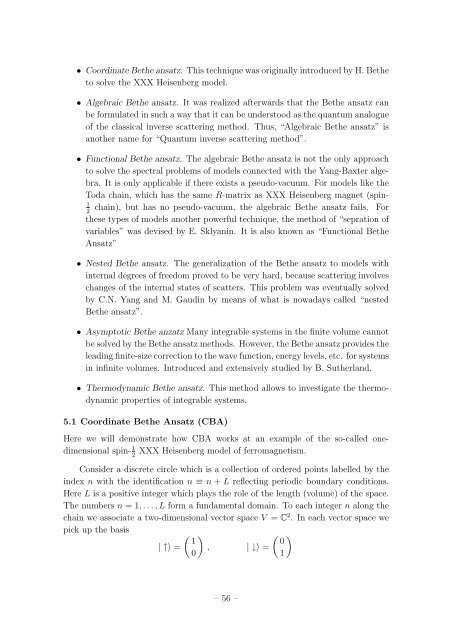Student Seminar: Classical and Quantum Integrable Systems
Student Seminar: Classical and Quantum Integrable Systems
Student Seminar: Classical and Quantum Integrable Systems
You also want an ePaper? Increase the reach of your titles
YUMPU automatically turns print PDFs into web optimized ePapers that Google loves.
• Coordinate Bethe ansatz. This technique was originally introduced by H. Bethe<br />
to solve the XXX Heisenberg model.<br />
• Algebraic Bethe ansatz. It was realized afterwards that the Bethe ansatz can<br />
be formulated in such a way that it can be understood as the quantum analogue<br />
of the classical inverse scattering method. Thus, “Algebraic Bethe ansatz” is<br />
another name for “<strong>Quantum</strong> inverse scattering method”.<br />
• Functional Bethe ansatz. The algebraic Bethe ansatz is not the only approach<br />
to solve the spectral problems of models connected with the Yang-Baxter algebra.<br />
It is only applicable if there exists a pseudo-vacuum. For models like the<br />
Toda chain, which has the same R-matrix as XXX Heisenberg magnet (spin-<br />
1<br />
chain), but has no pseudo-vacuum, the algebraic Bethe ansatz fails. For<br />
2<br />
these types of models another powerful technique, the method of “sepration of<br />
variables” was devised by E. Sklyanin. It is also known as “Functional Bethe<br />
Ansatz”<br />
• Nested Bethe ansatz. The generalization of the Bethe ansatz to models with<br />
internal degrees of freedom proved to be very hard, because scattering involves<br />
changes of the internal states of scatters. This problem was eventually solved<br />
by C.N. Yang <strong>and</strong> M. Gaudin by means of what is nowadays called “nested<br />
Bethe ansatz”.<br />
• Asymptotic Bethe anzatz Many integrable systems in the finite volume cannot<br />
be solved by the Bethe ansatz methods. However, the Bethe ansatz provides the<br />
leading finite-size correction to the wave function, energy levels, etc. for systems<br />
in infinite volumes. Introduced <strong>and</strong> extensively studied by B. Sutherl<strong>and</strong>.<br />
• Thermodynamic Bethe ansatz. This method allows to investigate the thermodynamic<br />
properties of integrable systems.<br />
5.1 Coordinate Bethe Ansatz (CBA)<br />
Here we will demonstrate how CBA works at an example of the so-called onedimensional<br />
spin- 1 XXX Heisenberg model of ferromagnetism.<br />
2<br />
Consider a discrete circle which is a collection of ordered points labelled by the<br />
index n with the identification n ≡ n + L reflecting periodic boundary conditions.<br />
Here L is a positive integer which plays the role of the length (volume) of the space.<br />
The numbers n = 1, . . . , L form a fundamental domain. To each integer n along the<br />
chain we associate a two-dimensional vector space V = C 2 . In each vector space we<br />
pick up the basis<br />
( )<br />
( )<br />
1 0<br />
| ↑〉 = , | ↓〉 =<br />
0 1<br />
– 56 –

















